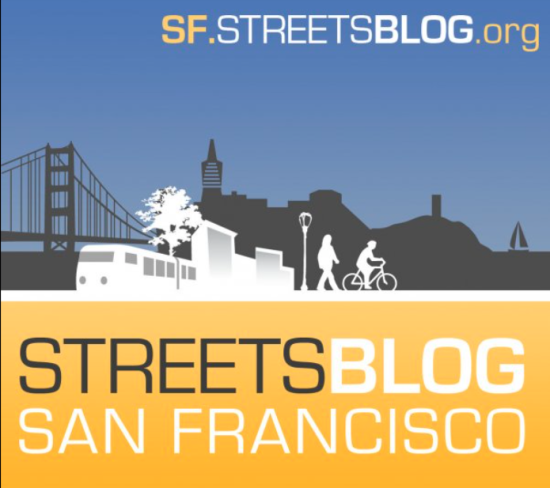 The future home of 299 Valencia will have more parking than the neighborhood plan allows of right
The future home of 299 Valencia will have more parking than the neighborhood plan allows of rightThe Board of Supervisors, in one the first tests of the new progressive bloc, failed to muster a supermajority vote to support an appeal that would have overturned the Planning Commission's approval of a conditional use (CU) permit, which allowed seven more parking spaces than the ratio set in the Market/Octavia Plan for a proposed condominium and commercial development at 299 Valencia Street.
The vote Tuesday followed two-and-half-hours of debate and public comment from advocates who fear the decision sets a bad precedent and violates the overall spirit of a sustainable neighborhood blueprint that took more than a decade to craft.
"The question is 'What kind of city we want?'" said Jeffrey Tumlin, principal of Nelson Nygaard Consulting Associates and transportation lead on the Market/Octavia Plan. "If we are going to override the zoning code that resulted from 10 years of intensive community process, what's the compelling social reason? How does [it] make the community better?"
At issue was a request by JS Sullivan Development LLC for a CU for the right to build .75 parking spaces for each residential unit for a new structure to be constructed at the corner of Valencia Street and 14th Street. The Market and Octavia plan of right only allows .5:1 parking spaces to dwelling units. In November, the Planning Commission, based on staff recommendations, voted 7-0 in favor of the CU, arguing the developer had done everything required to meet the threshold in Planning Code for the extra spaces. That decision was appealed to the Board of Supervisors.
It boils down to two sections of the planning code, 303 and 151.1(f). 303 broadly addresses the merits of conditional uses, i.e. necessity, desirability, and compatibility with the surrounding area. 151.1(f) is a checklist of specific conditions to be met to grant the parking CU, assuming the broader interpretation of 303 is appropriate.
The Planning Commission asserted the developer met the criteria in 151.1(f) and the developer argued that without the extra parking spaces they couldn’t afford to excavate for parking, forcing them to put parking at grade, though Planning Department staff present at the hearing informed the chamber that at-grade parking would be illegal under the plan.
The appellants, which include the Hayes Valley Neighborhood Association (HVNA), Livable City, the San Francisco Bicycle Coalition (SFBC), the Sierra Club, the AIDS Housing Alliance and others, argued that extra parking violates the context of one of the most transit-rich, bicycle-friendly, and pedestrian-scale neighborhoods in San Francisco.
 Developer argued that the future curb cut on Stevenson Lane would limit conflict with pedestrians and cyclists.
Developer argued that the future curb cut on Stevenson Lane would limit conflict with pedestrians and cyclists.Valencia and 14th Streets are two of the busiest bicycle routes in the city, with numerous Muni and BART transit options nearby, and the majority of the other buildings in the area have little to no on-site parking. Census numbers show only 27% of people living in the immediate area own cars. HVNA and Livable city warned if this CU was granted it would set a precedent that subsequent developers would use to argue for exceptions in their project, no small matter given that Whole Foods and other large projects are in the pipeline for the area.
Supervisors Elsbernd, Alioto-Pier, and Chu came into the hearing on the side of the developer with a strict interpretation of 151.1(f).
“What we wanted to grant a conditional use permit was specifically put in the code and this is the code we are asked to interpret,” said Supervisor Elsbernd, who spent much of the hearing pacing or standing and appearing none-too-pleased to spend his evening in chambers.
Supervisors Avalos, Campos, Chiu, Daly, Mar, Maxwell, and Mirkarimi all came into the hearing siding with the appellants and a broader interpretation of how the CU would impact the neighborhood. The wild card was Supervisor Dufty, who would not signal his position ahead of time to appellants who lobbied for his support. When Dufty chastised the developer’s lawyer, David Silverman, for depicting the appellants as carpetbaggers, it appeared he might lean toward supporting the appeal.
“I have to admit that your argumentation disappoints me. The people are not from Walnut Creek or Saratoga or Concord,” he said. “These are not… the barbarians at the gate.”
In the end though, Dufty cast his vote with the moderates to support the developer, killing the appeal, which required an 8-3 supermajority to pass. Dufty didn't return phone calls requesting comment.
Jason Henderson, vice president of the HVNA, said he wasn’t too surprised with the outcome, that the 7-4 split is the political alignment of the city currently. He was disappointed, however, that the sustainable transportation advocates seem to be at odds with the Planning Department and its analysis.
“It doesn’t need to be this divisive,” he said. “I hope to communicate to the Planning Department that we’re not going to be happy with just giving away these CUs in the future.”
Photos: Matthew Roth





